Guest post by John Lang of Friendly Tree.
Spring is a wonderful time of year, when everything around us is bursting to life. This, of course, includes pesky insects that have it out for your trees.
As the weather warms up, pests come out of the woodwork, so to speak, and you’ll want to know what signs to look for. When trees are stressed after a long winter, they are especially susceptible to attack.
These are some of the most destructive and prevalent insects that can cause serious damage to your tree and even lead to tree death.
Defoliators
Gypsy Moth
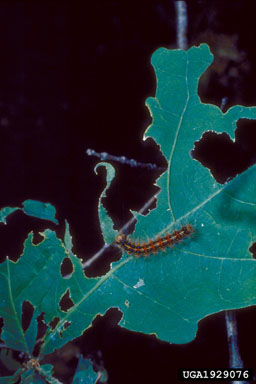
USDA Forest Service , USDA Forest Service, Bugwood.org
The gypsy moth is notorious for defoliating more than a million forested acres each year since 1980. As leaves emerge in the spring, the moths leave masses of eggs which hatch into hungry larvae. The moth’s larvae defoliate hardwood trees, especially oak, birch, elm and maple.
Look for yellowish, teardrop-shaped egg masses, which may contain up to 500 eggs, and can usually be found on tree trunks in the spring. Damage can range from leaf damage to complete defoliation.
Western Tent Caterpillar
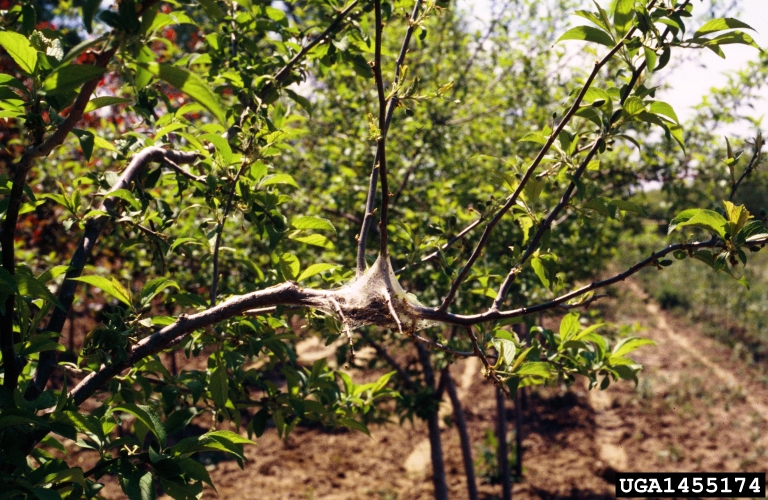
Whitney Cranshaw, Colorado State University, Bugwood.org
The western tent caterpillar attacks a wide range of trees including poplar, willow, cottonwood, quaking aspen and especially fruit trees. A tell-tale sign is their white silken tents in mid to late spring. The larvae live in a colony, feeding together and expanding their tent as the season progresses. Shriveled or brown foliage and defoliation beginning at the top and outer branches are the first signs of a western tent caterpillar infestation.
Eastern Tent Caterpillar
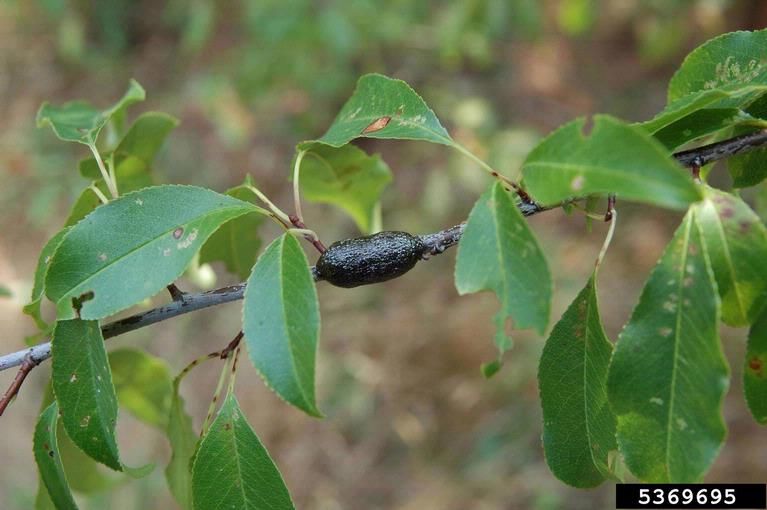
Brian Kunkel, University of Delaware, Bugwood.org
Appearing in the spring in the eastern United States, tent caterpillars feed on oaks, aspens, sugar maples and other hardwood shade trees. The caterpillars emerge in the early spring, around the same time trees begin to bud. Signs of infestation include the presence of large silken tents, stunted tree growth and stripped leaves.
Douglasfir Tussock Moths
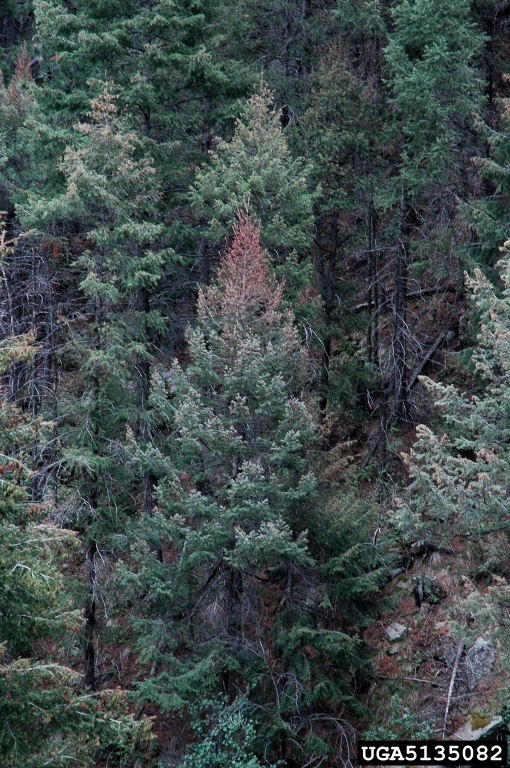
William M. Ciesla, Forest Health Management International, Bugwood.org
While the Douglas-fir tussock moth prefers Douglas-firs, it can also attack blue spruce and other firs in urban settings. Since the tussock moth likes to stays put, trees tend to be attacked yearly until they are considerably damaged. You can first spot them in the late spring, when the larvae begin feeding on new needles. Reddish-brown foliage first at the tree’s top and outer branches, and later on lower and inner branches, may indicate a tussock moth attack. You might also see egg masses on the lower tree canopy – but be careful not to touch the larvae once it emerges; tiny hairs on the larvae can cause skin irritations and allergic reactions.
Spruce Budworm
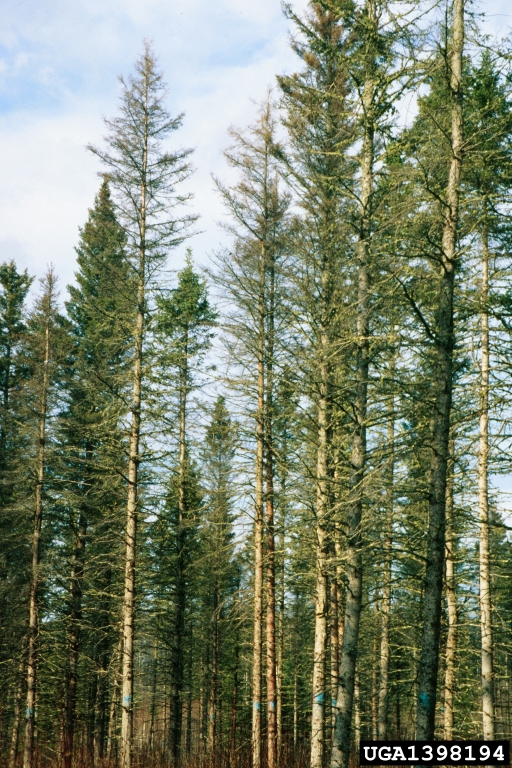
Steven Katovich, USDA Forest Service, Bugwood.org
The spruce budworm attacks spruce and fir forests in the eastern U.S. and is one of the most destructive insects when it comes to defoliation and tree death. Budworm larvae hatch by the thousands and have the potential to consume a tree’s entire new growth. Dead branches on spruce and fir trees may indicate a budworm outbreak. Proper tree pruning methods can help prevent outbreaks.
Watch Ask an Arborist: How do I Check for Tree Pests?
Wood Borers
Emerald Ash Borer

Ryan Armbrust, Kansas Forest Service, Bugwood.org
The emerald ash borer kills millions of ash trees each year. Adult borers are very small and difficult to spot, but trees infested with the emerald ash borer will exhibit serpentine, S-shaped feeding galleries packed with frass and sawdust. Later in the season, you may see D-shaped holes in the bark as the adults emerge. Ash trees with crown dieback from the top down and yellowing foliage are typically infested with the emerald ash borer.
Asian Longhorn Beetle/Borer

Steven Katovich, USDA Forest Service, Bugwood.org
The Asian Longhorn Beetle was first found in the late 1990s in Brooklyn, NY but has since spread to more than 14 other states. Deep feeding galleries weaken the infested tree and cause it to fall apart. Yellow or drooping leaves, pencil-shaped exit holes and sawdust buildup near the base of the tree may indicate an asian longhorn beetle infestation. Moving firewood or wood debris from host trees can spread the pests.
Bark Beetles
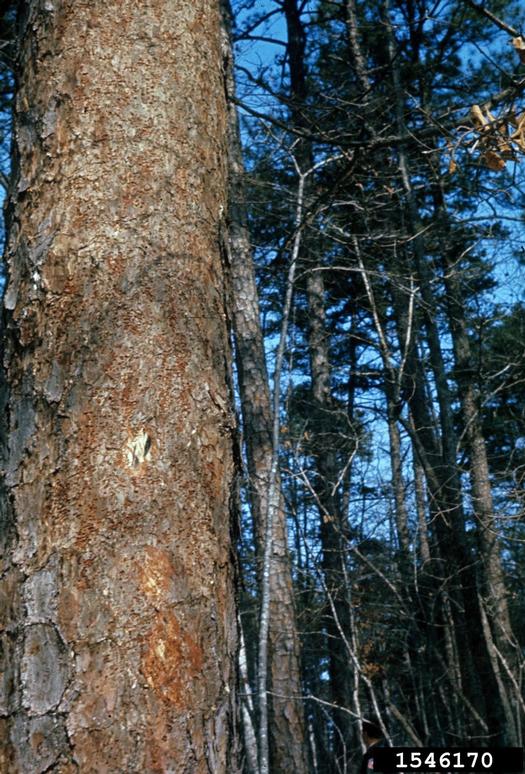
C Doggett, Bugwood.org
There are several different types of bark beetles, which can attack both hardwoods and conifers. The beetle itself doesn’t cause critical damage as much as the diseases it spreads. The beetles transmit spores as they move from tree to tree, spreading disease.
Trees with white or brown pitch tubes (small sap-like blobs) on the outside of the bark or conifers with reddish-brown needles spreading from the top of the tree down indicate a bark beetle problem.
Sap-Sucking Insects
Aphids
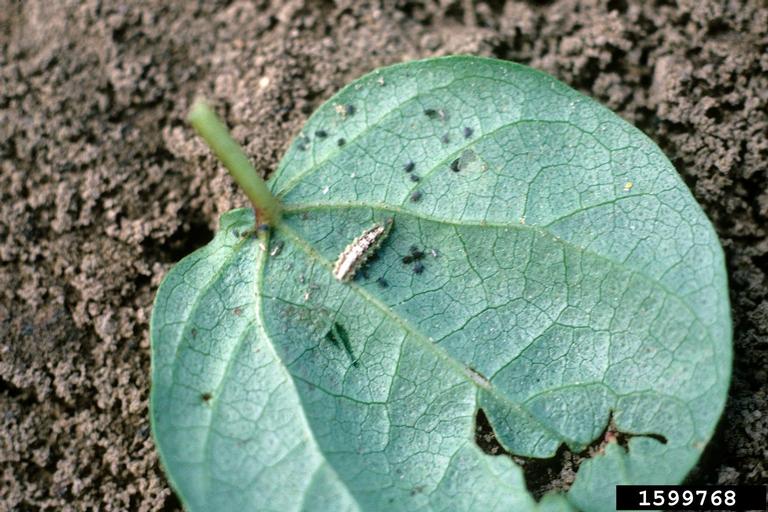
John C. French Sr., Retired, Universities:Auburn, GA, Clemson and U of MO, Bugwood.org
Aphids eat away at the sap in tree leaves and stems, leaving behind a sticky syrup called honeydew. Large infestations of aphids can stunt new leaf growth and cause misshapen, curling or yellow leaves. You can spot an aphid infestation by checking the underside of leaves for the pests, or checking for sooty mold, which is often attracted to honeydew.
Scale Insects

Milan Zubrik, Forest Research Institute – Slovakia, Bugwood.org
Scale insects feed on the inner part of a tree’s bark and can cause leaf yellowing, stunted growth, branch dieback and tree death. Scale insects leave behind a layer of sooty mold, and you can also spot their colorful clumps on leaves and twigs. The last few weeks of winter is the time to treat infected trees before they arrive again in the spring.
Now is the time to keep your eyes open for these devastating pests. If your tree is showing unusual yellowing or premature leaf drop, or if you spot any of the above symptoms of insect infestation, contact your local arborist for treatment options before it’s too late.
About the Author
John Lang is a Certified Arborist and a member of the Friendly Tree team, a family-owned New Jersey tree care service, dedicated to the thoughtful and careful maintenance of your trees and shrubs. Friendly Tree Service has been in business for 26 years and remains passionate about trees and nature. With a highly trained staff that treats every property as their own and state of the art equipment, Friendly Tree is on the cutting edge of the art and science of Arboriculture.





Need to know what this is. Is this a pest or fungus
. i have a pictue of the question but i cant paste in into this area.
Hi Patricia,
We encourage you to reach out to your county extension office to help identify the pest or fungus that could be plaguing your tree. These often start at the local level and your county extension could provide you more information on how to treat it.
It was great you mentioned that aphids leave a sticky syrup in the leaves. My mom noticed her strawberries are misshapen, and the leaves have turned yellow. I’ll let her know that she might have an infestation of aphids so she can call a pest control company.
Our large oaks have whole branches without leaves. The young trees we planted have bare branches ie oaks or spots. No other evidence. I do not see any webs or evidence of insects or egg masses. The young oaks as well as elm, maple have been affected. We have a 12 foot heritage oak with bare branches, withering leaves, no evidence of insects.